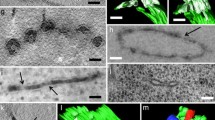Summary
The formation of three types of vesicles in the oomycetePhytophthora cinnamomi was investigated using ultrastructural and immunocytochemical techniques. All three vesicles are synthesised at the same time; one type serves a storage role; the others undergo regulated secretion. A monoclonal antibody Lpv-1 that is specific for glycoproteins contained in the storage vesicles labelled the endoplasmic reticulum (ER), elements in the transition region between ER and Golgi stack, and cis, medial and trans Golgi cisternae. Cpa2, a monoclonal antibody specific for glycoproteins contained within secretory dorsal vesicles labelled the transition region, cis cisternae and a trans-Golgi network. Vesicles possessing a structure characteristic of mature secretory ventral vesicles were observed in close association with the trans face of Golgi stacks. The results suggest that all three vesicles are formed by the Golgi apparatus. Double immunogold labelling with Lpv-1 and Cpa-2 showed that these two sets of glycoproteins occurred within the same Golgi cisternae, indicating that both products pass through and are sorted concurrently within a single Golgi stack.
Similar content being viewed by others
References
Beakes GW (1989) Oomycete fungi: their phylogeny and relationship to chromophyte algae. In: Green JC, Leadbetter BSC, Diver WL (eds) The chromophyte algae: problems and perspectives. Clarendon Press, Oxford, pp 325–342
Burgess TL, Kelly RB (1987) Constitutive and regulated secretion of proteins. Annu Rev Cell Biol 3: 243–293
Chrispeels MJ (1985) The role of the Golgi apparatus in the transport and post-translational modification of vaculoar (protein body) proteins. Oxford Surv Plant Mol Cell Biol 2: 43–68
—, Staehelin LA (1992) Budding, fission, transport, targeting, fusion — frontiers in secretion research. Plant Cell 4: 1008–1016
Dargent R, Touzé-Soulet J-M, Rami J, Montant C (1982) Cytochemical characterization of Golgi apparatus in some filamentous fungi. Exp Mycol 6: 101–114
Driouich A, Faye L, Staehelin LA 81993) The plant Golgi apparatus: a factory for complex polysaccharides and glycoproteins. Trends Biochem Sci 18: 201–214
Farquhar MG (1985) Progress in unravelling pathways of Golgi traffic. Annu Rev Cell Biol 1: 447–488
Förster H, Mendgen K (1987) Immunocytochemical localization of pectinesterases in hyphae ofPhytophthora infestans. Can J Bot 65: 2607–2613
Grove SN, Bracker CE, Morré DJ (1968) Cytomembrane differentiation in the endoplasmic reticulum-Golgi apparatus-vesicle complex. Science 161: 171–173
Gubler F, Hardham AR (1988) Secretion of adhesive material during encystment ofPhytophthora cinnamomi zoospores, characterized by immunogold labelling with monoclonal antibodies to components of peripheral vesicles. J Cell Sci 90: 225–235
— — (1990) Protein storage in large peripheral vesicles inPhytophthora zoospores and its breakdown after cyst germination. Exp Mycol 14: 393–404
Gunderson JH, Elwood H, Ingold A, Kindle K, Sogin ML (1987) Phylogenetic relationships between chlorophytes, chrysophytes and oomycetes. Proc Natl Acad Sci USA 84: 5823–5827
Hardham AR, Gubler F (1990) Polarity of attachment of zoospores of a root pathogen and pre-alignment of the emerging germ tube. Cell Biol Int Rep 14: 947–956
—, Suzaki E (1990) Glycoconjugates on the surface of spores of the pathogenic fungusPhytophthora cinnamomi studied using fluorescence and electron microscopy and flow cytometry. Can J Microbiol 36: 183–192
— —, Perkin JL (1986) Monoclonal antibodies to isolate-, species„ and genus-specific components on the surface of zoospores and cysts of the fungusPhytophthora cinnamomi. Can J Bot 64: 311–321
—, Gubler F, Duniec J, Elliott J (1991) A review of methods for the production and use of monoclonal antibodies to study zoosporic plant pathogens. J Microsc 162: 305–318
Heath IB, Rethoret K, Arsenault AL, Ottensmeyer FP (1985) Improved preservation of the form and contents of wall vesicles and the Golgi apparatus in freeze substituted hyphae ofSaprolegnia. Protoplasma 128: 81–93
Jones RL, Robinson DG (1989) Protein secretion in plants. New Phytol 111: 567–597
Kelly RB (1991) Secretory granule and synaptic vesicle formation. Curr Opin Cell Biol 3: 654–660
Melkonian M, Becker B, Becker D (1991) Scale formation in algae. J Electron Microsc Tech 17: 165–178
Moore PJ, Swords KMM, Lynch MA, Staehelin LA (1991) Spatial reorganization of the assembly pathways of glycoproteins and complex polysaccharides in the Golgi apparatus of plants. J Cell Biol 112: 589–602
Roth J (1984) Cytochemical localization of terminalN-acetyl-D-galactosamine residues in cellular compartments of intestinal goblet cells: implications for the topology of O-glycosylation. J Cell Biol 98: 399–406
Sherrier DJ, VandenBosch KA (1994) Secretion of cell wall polysaccharides inVicia root hairs. Plant J 5: 185–195
Author information
Authors and Affiliations
Rights and permissions
About this article
Cite this article
Dearnaley, J.D.W., Hardham, A.R. The Golgi apparatus ofPhytophthora cinnamomi makes three types of secretory or storage vesicles concurrently. Protoplasma 182, 75–79 (1994). https://doi.org/10.1007/BF01403692
Received:
Accepted:
Issue Date:
DOI: https://doi.org/10.1007/BF01403692




